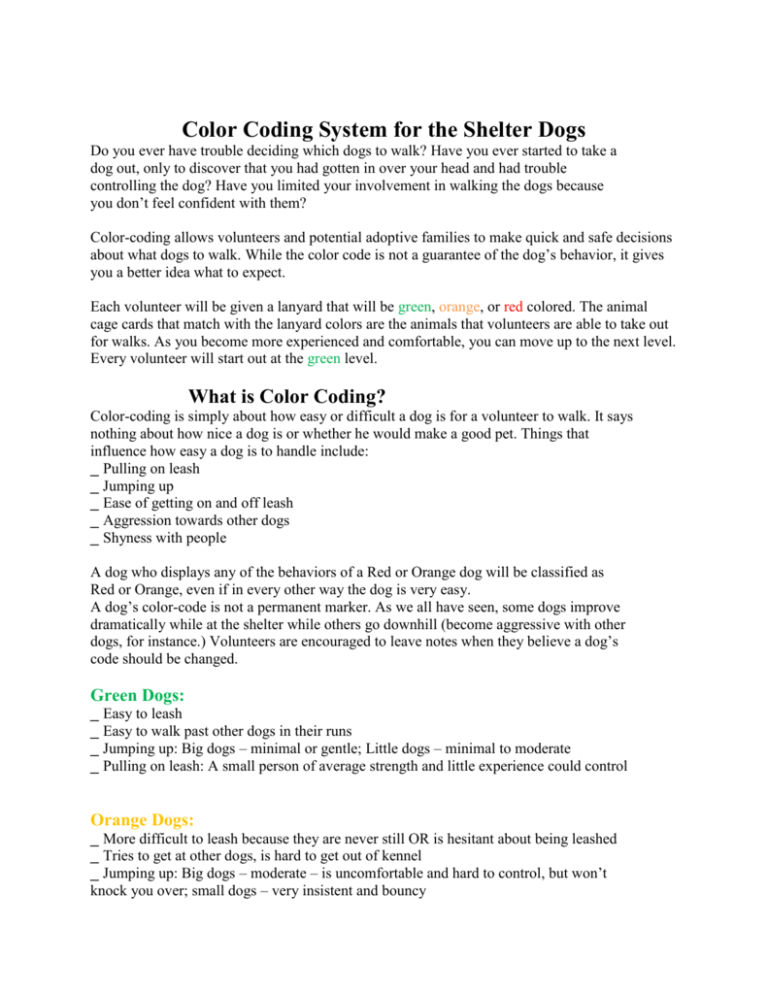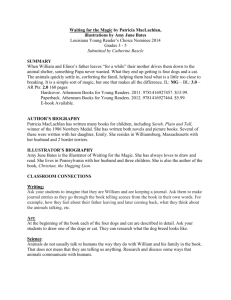Color Coding System for the Shelter Dogs
advertisement

Color Coding System for the Shelter Dogs Do you ever have trouble deciding which dogs to walk? Have you ever started to take a dog out, only to discover that you had gotten in over your head and had trouble controlling the dog? Have you limited your involvement in walking the dogs because you don’t feel confident with them? Color-coding allows volunteers and potential adoptive families to make quick and safe decisions about what dogs to walk. While the color code is not a guarantee of the dog’s behavior, it gives you a better idea what to expect. Each volunteer will be given a lanyard that will be green, orange, or red colored. The animal cage cards that match with the lanyard colors are the animals that volunteers are able to take out for walks. As you become more experienced and comfortable, you can move up to the next level. Every volunteer will start out at the green level. What is Color Coding? Color-coding is simply about how easy or difficult a dog is for a volunteer to walk. It says nothing about how nice a dog is or whether he would make a good pet. Things that influence how easy a dog is to handle include: _ Pulling on leash _ Jumping up _ Ease of getting on and off leash _ Aggression towards other dogs _ Shyness with people A dog who displays any of the behaviors of a Red or Orange dog will be classified as Red or Orange, even if in every other way the dog is very easy. A dog’s color-code is not a permanent marker. As we all have seen, some dogs improve dramatically while at the shelter while others go downhill (become aggressive with other dogs, for instance.) Volunteers are encouraged to leave notes when they believe a dog’s code should be changed. Green Dogs: _ Easy to leash _ Easy to walk past other dogs in their runs _ Jumping up: Big dogs – minimal or gentle; Little dogs – minimal to moderate _ Pulling on leash: A small person of average strength and little experience could control Orange Dogs: _ More difficult to leash because they are never still OR is hesitant about being leashed _ Tries to get at other dogs, is hard to get out of kennel _ Jumping up: Big dogs – moderate – is uncomfortable and hard to control, but won’t knock you over; small dogs – very insistent and bouncy _ Pulling on leash: Requires strength and skill to walk, but won’t pull a person of average size and strength off their feet Red Dogs: _ Difficult to leash: Bites at leash, tries to evade leash by jumping, pawing, escaping OR won’t approach front of run and must be noosed _ Very difficult to keep from approaching other dogs (sometimes in an antagonizing way) when taking out _ Jumping up: Is very forceful, could injure or knock over an unprepared person _ Pulling on leash: person of average size and strength could be knocked over Uncoded Dogs: Dogs that have not yet been evaluated, are not yet up for adoption (seven day hold) or are under quarantine. Also dogs that have been evaluated, but are not safe for volunteers to handle (aggressive or feral dogs, for instance) or cannot be leashed or walked due to injury. How to Walk a Shelter Dog Taking a dog for a walk might seem as simple a task as tying your shoelaces, but giving shelter dogs a little exercise involves more than just grabbing a leash and running out the nearest door. As a volunteer you'll need to do a few things to ensure your safety, the safety of the animals, and the safety of shelter workers and visitors. 1: First Things First If you're a volunteer dog walker, please check in at the front desk as soon as you arrive, so that the staff knows you will be in the kennels. You will be required to show your lanyard at check in. Every time you take a dog for a stroll, you're teaching him how to respond to his caretakers and his environment. If you can spend a few moments teaching an unruly, overanxious dog how to behave, you'll not only make future walks go more smoothly but also increase that dog's chances of finding a lifelong home 2: Select the Proper Attire Sometimes things at the shelter can get messy so dress appropriately! Please wear closed toe shoes, blue jeans, and clothes that you wouldn’t mind getting dirty. When you are ready to take a dog out for a walk, please use the leashes provided at the front counter. Loop the leash around the dog’s neck the way that was shown in the volunteer training orientation. 3: Don't Let 'Em Walk All Over You Before you open the kennel, have the leash ready and be sure you know how to work the latch. You can take a few moments to practice on an empty cage until you feel comfortable; the ability to quickly open and close a cage door will be important when you are placing the animal back in the kennel. Before you and your companion exit the kennels, look out for other dog walkers and members of the public, and wait until the coast is clear. 4. Mind your manners! While out with a dog, please do not place the dog in a pen with another animal. If you are walking a dog and another volunteer walking a dog approaches, please shorten the leash and be alert of the dog until they pass by. Dog fights are rare at the shelter, but they do happen, so it is important to be diligent and alert. 5. When in doubt, ask! If you see something that needs to be done, please visit the front desk and ask for a supervisor. The shelter utilizes prisoners (trustys) on work release to handle all feeding and cleaning of the animals. Do not socialize with the trustys, or provide any contraband. If you see something that needs attending to, go directly to the front desk to notify a supervisor or staff member. ALWAYS MAKE SURE THAT THE DOG’S COLOR CODE MATCHES YOUR LANYARD! Guidelines For Dog Walkers All dogs will have a colored sticker on their cage card. The color of the sticker MUST match your lanyard in order to take the dog outside. (Green lanyards can only walk dogs who cage card has a green color sticker). Leashes are located by the front desk. We will go over the exact location of leashes, and how to leash a dog, after the class. When you are walking a dog, you may only walk one dog at a time. Also, only one dog per pen is allowed. IF you walk multiple dogs or place multiple dogs in the pen without administration permission, you may be asked to no longer volunteer at the shelter. Our first priority is public safety, and volunteers must follow the guidelines that will keep them and the animals safe. If you are under 18 (but at least 12 years of age), you must have a parent/guardian walk the dogs. Stray animals (red cage cards) cannot leave the kennel, under any circumstances. If you see an animal that you think the vet staff should evaluate, but is a non-emergency, there is a white board by the vet office you can write the animals’ ID number and a brief description of the problem. We will go over this after the class. Trustys (prisoners on work release) work at the shelter and provide cleanup and food to all animals. DO NOT interact with the trustys, and absolutely no contraband. Volunteers are imperative to the successful placement of our animals. We need volunteers to help keep the dogs exercised and social. Volunteers my come to walk dogs anytime the shelter is open. Below are our business hours: Monday- 10am-6pm Tuesday- 10am-5pm Wednesday- 10am-5pm Thursday-10am-5pm Friday-10am-6pm Saturday-10am-4pm Dear Volunteer, Thank you so much for choosing to participate in our shelter volunteer program. We could not do what we do without dedicated and caring people like you, who help keep our animals happy. There are many roles aside from dog walking that volunteers can fill at the shelter. If you are interested in learning more, please check out our volunteer page on the website (www.oakgov.com/petadoption) or feel free to contact Mark Christopher at christopherm@oakgov.com Once you have taken the training, if you would like more training, we can pair you with one of our longtime volunteers for a hands-on experience. We want every person who volunteers at the shelter to feel comfortable and safe; volunteering is fun and we want to make sure you are having lots of fun! Please review the paperwork that you are given in class. It is important that you understand and follow the policies of the shelter. These policies are to protect you and our animals, which will keep everyone happy and safe. Thank you again for choosing to work with our shelter animals. I look forward to seeing you around the shelter! Kind regards, Alexis Shull Public Relations Coordinator



